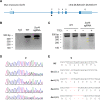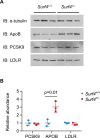Murine Surf4 is essential for early embryonic development
- PMID: 31978056
- PMCID: PMC6980569
- DOI: 10.1371/journal.pone.0227450
Murine Surf4 is essential for early embryonic development
Abstract
Newly synthesized proteins co-translationally inserted into the endoplasmic reticulum (ER) lumen may be recruited into anterograde transport vesicles by their association with specific cargo receptors. We recently identified a role for the cargo receptor SURF4 in facilitating the secretion of PCSK9 in cultured cells. To examine the function of SURF4 in vivo, we used CRISPR/Cas9-mediated gene editing to generate mice with germline loss-of-function mutations in Surf4. Heterozygous Surf4+/- mice exhibit grossly normal appearance, behavior, body weight, fecundity, and organ development, with no significant alterations in circulating plasma levels of PCSK9, apolipoprotein B, or total cholesterol, and a detectable accumulation of intrahepatic apoliprotein B. Homozygous Surf4-/- mice exhibit embryonic lethality, with complete loss of all Surf4-/- offspring between embryonic days 3.5 and 9.5. In contrast to the milder murine phenotypes associated with deficiency of known SURF4 cargoes, the embryonic lethality of Surf4-/- mice implies the existence of additional SURF4 cargoes or functions that are essential for murine early embryonic development.
Conflict of interest statement
DG is a Howard Hughes Medical Institute investigator. This does not alter our adherence to PLOS ONE policies on sharing data and materials.
Figures




References
-
- Yin Y, Garcia MR, Novak AJ, Saunders AM, Ank RS, Nam AS, et al. Surf4 (Erv29p) binds amino-terminal tripeptide motifs of soluble cargo proteins with different affinities, enabling prioritization of their exit from the endoplasmic reticulum. PLoS Biol. 2018;16(8):e2005140 Epub 2018/08/08. 10.1371/journal.pbio.2005140 - DOI - PMC - PubMed
Publication types
MeSH terms
Substances
Grants and funding
LinkOut - more resources
Full Text Sources
Molecular Biology Databases
Research Materials
Miscellaneous

